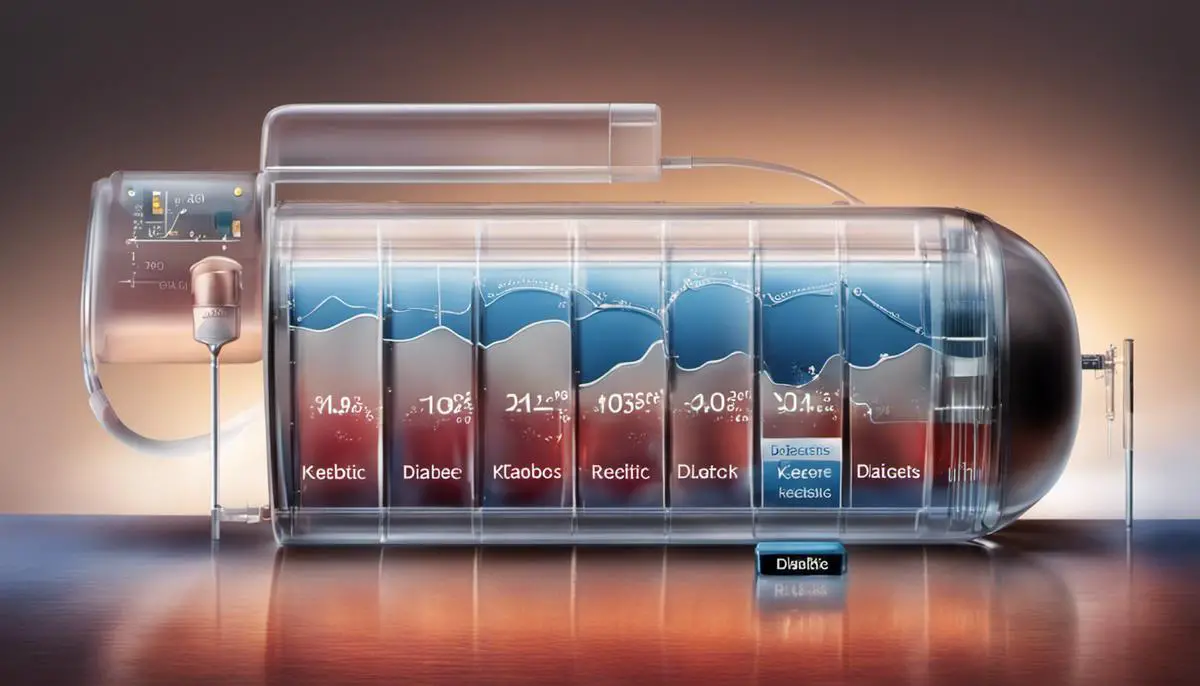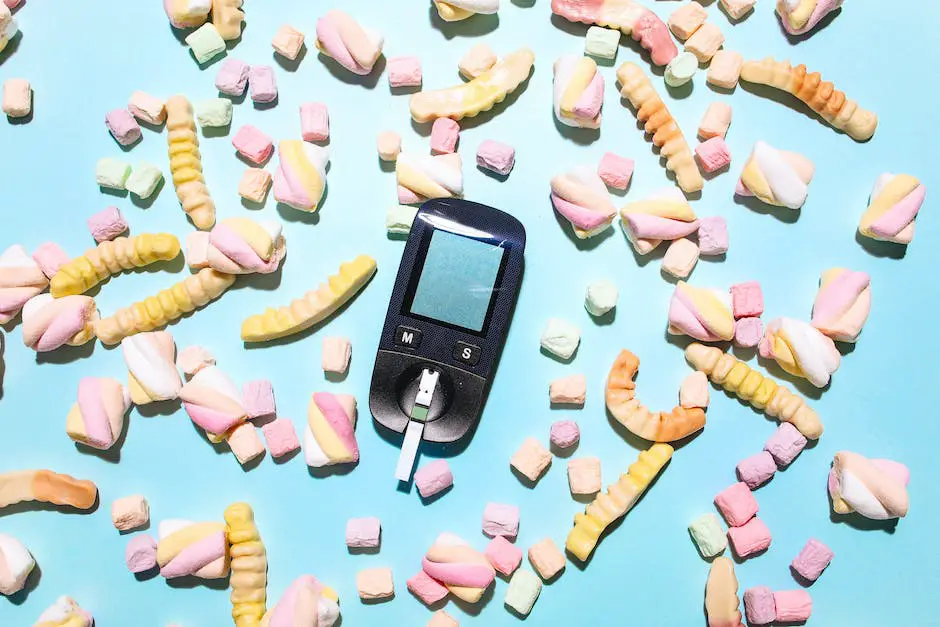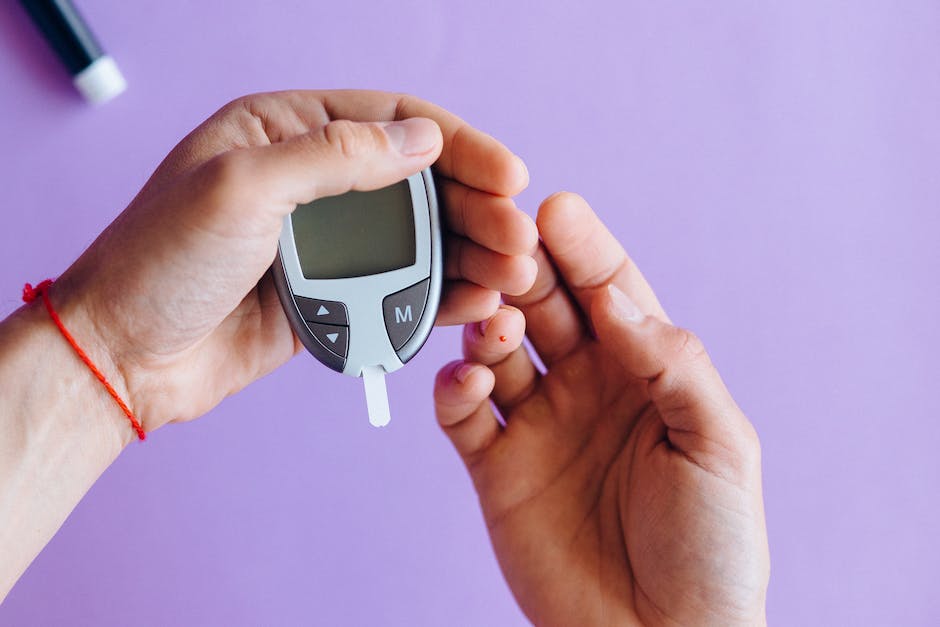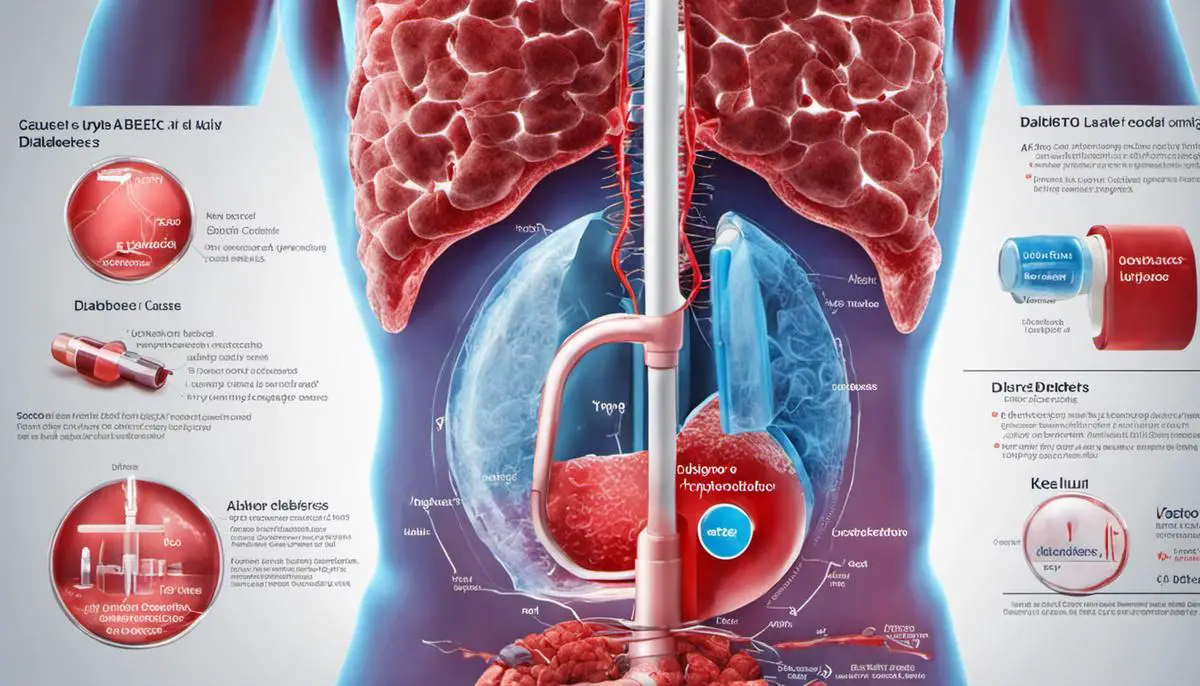Understanding Diabetic Ketoacidosis (DKA), particularly in the context of Type 1 Diabetes, is crucial for both individuals at risk and the general public. This complex health condition, involving a dangerous build-up of acids called ketones in the bloodstream due to insufficient insulin, poses significant health risks. It’s important to garner knowledge about the symptoms often exhibited by DKA, such as excessive thirst and unusual fatigue, and how a diagnosis is made using blood and urine tests.
- Getting clear on the risk factors linked to the development of DKA, such as certain lifestyle choices and genetic precursors, is key. This can help with understanding prevention strategies, which include maintaining structured control over blood glucose levels, regular checkups, and leading a balanced, healthy life.
- Knowledge about various treatments methods, including fluid and electrolyte replacement as well as insulin therapy, could well be life-saving. Additionally, effective management to hinder recurrence is equally vital.
Aside from medical facts and recommendations, gaining personal insight into living with Type 1 Diabetes and DKA can be instrumental to foster empathy and offer genuine support. Personal stories and coping strategies, as well as avenues for further support, add a human touch to factual data.
Definition and Causes of DKA
Definition of Diabetic Ketoacidosis (DKA)
Diabetic Ketoacidosis (DKA) is a dangerous and severe complication that can occur in individuals with diabetes, especially those with Type 1 diabetes. It happens when your body doesn’t have enough insulin, a hormone that’s vital for sugar (glucose) to enter cells for energy. This lack of insulin leads to the body’s need to start breaking down fat as fuel, which produces ketones. Ketones are acids that build up in the blood and appear in the urine when your body doesn’t have enough insulin.
The Role of Insulin and Glucose Management in DKA
In a perfect system, the hormone insulin, which is produced by the pancreas, helps regulate the amount of glucose in our blood, ensuring our bodies have enough, but not too much, to function correctly. For people with Type 1 diabetes, the body does not produce insulin. Without this crucial hormone, glucose can’t enter cells and builds up in the bloodstream, causing hyperglycemia (high blood sugar).
The Creation of Ketones and Development of DKA
When the cells of the body are deprived of the glucose they require for energy, the body, thinking it is starving, begins to break down stored fat. The liver processes the fat into a fuel called ketones, which causes the blood to become acidic. If not treated immediately, high levels of ketones can lead to a serious condition known as ketoacidosis and then diabetic ketoacidosis (DKA), which is potentially life-threatening.
Type 1 Diabetes And DKA
DKA is more common in people with Type 1 diabetes because they do not produce insulin. Factors that can lead to DKA in someone with Type 1 diabetes include not taking enough insulin, an insulin pump that is not working correctly, illness or infection, and severe physical or emotional stress. The risk of DKA is also higher in the first year after diagnosis with type 1 diabetes, during periods of illness, and when glucose levels are consistently high. Regular monitoring of blood glucose and ketone levels is crucial in people with type 1 diabetes to prevent DKA.
DKA Symptoms
Individuals with DKA may experience symptoms that include frequent urination, extreme thirst, nausea or vomiting, abdominal pain, weakness or fatigue, shortness of breath, confusion and fruity-scented breath.
Imperative Immediate Care for DKA
Any individual demonstrating indications of or diagnosed with Diabetic Ketoacidosis (DKA), a serious complication for those with Type 1 diabetes, should seek urgent medical care. Standard treatment usually involves hydration and electrolyte replacement to compensate for the substantial loss through frequent urination, and insulin therapy to counteract the effects causing the DKA. Early detection and effective management of Type 1 diabetes are essential in avoiding the onset of DKA.

Symptoms and Diagnosis of DKA
Recognizing Signs of DKA in Type 1 Diabetes
Typically, symptoms of Diabetic Ketoacidosis, or DKA, surface rapidly, within a span of 24 hours. These symptoms can be life-threatening if proper and timely treatment is not administered.
A significant indication of DKA is the presence of high blood glucose levels, often manifesting as constant thirst and frequent urination. These occur as the body attempts to eliminate the excess glucose. However, it’s also possible for someone to have DKA without noticeably high blood sugar levels, a condition referred to as euglycemic DKA.
Along with these symptoms, a person with DKA might undergo extreme fatigue as the body, unable to utilize sugar for energy due to the insulin deficiency, resorts to burning fat and muscle instead, leading to a buildup of ketones in the blood and urine. This drastic metabolic alteration can prompt rapid weight loss, another potential symptom of DKA.
Other warning signs may include a surge in ketone levels in the urine, nausea or vomiting (which could hinder fluid intake, possibly causing dehydration), abdominal pain, breathlessness, the presence of fruity-scented breath, and difficulties in concentration or overall confusion.
Diagnosing Diabetic Ketoacidosis (DKA)
Identifying Diabetic Ketoacidosis (DKA), a serious complication often experienced by individuals with Type 1 diabetes, starts with a physical check-up and a discussion of symptoms. Activities such as routine tests are necessary to verify the suspicion of DKA.
The checking of blood glucose levels is facilitated by a simple but efficient tool called a blood test. Blood glucose in the body exceeding 250 mg/dL usually implies a DKA situation. This medical procedure also evaluates the blood’s acidity degree and presence of ketones. People with DKA generally demonstrate high acidity and ketone levels in their blood.
Another key tool used to pinpoint DKA is the urine test. This involves scrutinizing a urine sample to determine the existence and concentration of ketones. Surplus ketones indicate that the body, lacking glucose, burns fat and muscle for energy, thus hinting at DKA.
When the condition worsens, physicians resort to additional testing methods like electrolyte tests, blood gas analysis, and kidney function tests. These tests assist in determining DKA’s intensity and planning a suitable treatment approach.
Swift recognition and medical intervention are critical when it comes to DKA, an emergency that necessitates immediate medical attention. DKA can progress into a coma or even death if not treated promptly, emphasizing the significance of familiarizing oneself with DKA symptoms and tests, especially among individuals with Type 1 diabetes.

Risk Factors and Prevention of DKA
DKAs Risk Factors in Type 1 Diabetes Ppatients
Diabetic Ketoacidosis (DKA) is a dangerous condition often seen in people diagnosed with Type 1 diabetes. High blood glucose levels and excess ketones in urine are indicative of this condition, along with greater blood acidity levels.
There are several factors that heighten the risk of DKA development. These include missed insulin doses, dehydration, stress, surgery, and alcohol or substance abuse. Illness or infection can also set off DKA. Certain disorders like cardiovascular disease, kidney disease, and pancreatitis further elevate risk levels.
The risk is higher in people with a history of DKA, inadequate access to health care, limited health literacy, or certain mental health conditions. Unmonitored diabetes, due to irregular check-up of blood glucose or insulin levels, may also precipitate DKA.
Furthermore, age and ethnicity are significant risk factors. While DKA can transpire at any age, it’s frequently seen in individuals below 19 years, especially during teenage years. Observations also highlight that African Americans, Hispanics, and Native Americans are at a greater risk of DKA in comparison to Caucasians.
Practical Strategies to Prevent DKA in Type 1 Diabetes
Averting DKA chiefly hinges on the effective management of blood glucose levels. Integral steps include diligent monitoring of blood sugar and ensuring sufficient insulin intake. It is advisable for diabetics to refrain from skipping insulin doses and to monitor their blood glucose levels periodically throughout the day as suggested by their health care provider.
Adhering to a wholesome lifestyle plays a considerable role in managing diabetes and thwarting DKA. Consuming a balanced diet that works to stabilizing the blood sugar levels and indulging in regular physical workouts is strongly recommended. Keeping hydrated also plays a key role in optimizing blood sugar control and minimizing the risk of DKA.
Being sick or under stress often leads to abnormal blood glucose levels, making it imperative for diabetics to formulate sick-day management strategies in conjunction with their healthcare providers. This generally includes modifying insulin doses, performing more frequent blood glucose checks, and testing for urinary ketones.
Regular medical evaluations, periodic lab assessments, diabetes education, and active communication with the healthcare team are all essential elements in the prevention of DKA. Such initiatives facilitate tailored advice, early detection of potential issues, and expedited treatment of complications.
Furthermore, early identification of DKA symptoms such as excessive thirst, frequent urination, high blood sugar levels, and occurrence of ketones in urine is critical. Swift action in response to these warning signs can prevent DKA, such actions may involve reaching out to a healthcare provider, upping fluid intake, and administering additional insulin when necessary.
In conclusion, the risk factors contributing to DKA in type 1 diabetes are multi-dimensional, they include genetic predisposition, lifestyle habits, socio-economic factors, etc. However, through vigilant blood glucose control, healthy lifestyle choices, and regular health evaluations, the onset and impact of DKA can be significantly curtailed.

Treatment and Management of DKA
Implementing Fluid Replacement for DKA Management
A fundamental component in the treatment of Diabetic Ketoacidosis (DKA) is fluid replacement. In situations of DKA, severe dehydration often occurs due to elevated levels of blood glucose, resulting in frequent urination and considerable loss of body fluids. To rectify this, healthcare professionals typically introduce intravenous fluids to restore the body’s water balance and to dilute the surplus sugar circulating in the bloodstream.
Electrolyte Replacement in DKA Management
Another component of DKA treatment is electrolyte replacement. Electrolytes, including potassium, sodium, and chloride, regulate our heart and nerve function, among other bodily processes. DKA often leads to a depletion of these electrolytes because they follow water and glucose out of the body when large amounts of urine are produced. Sodium bicarbonate is often given intravenously to correct the acidity of the blood, while potassium supplementation is provided to prevent hypokalemia, a condition that can result in fatal heart arrhythmias.
Insulin Therapy in DKA Management
Insulin therapy is a key element in treating DKA in individuals with Type 1 diabetes. Administration of insulin can help to lower the elevated blood glucose levels by aiding the process of glucose entering the cells. This suppresses further production and accumulation of ketones in the bloodstream, thereby neutralizing acidity. It’s important to note that medical professionals administer insulin gradually and carefully to avoid rapid reduction of blood sugar levels, which can lead to cerebral edema, a dangerous condition.
Long-Term Management of DKA
Beyond these immediate treatment strategies, long-term management of DKA is essential to prevent recurrent episodes. This includes consistent and routine monitoring of blood glucose levels to ensure they remain within the recommended range. Education on recognizing early symptoms of DKA can help individuals seek timely medical assistance, preventing condition aggravation.
Adherence to insulin therapy is crucial. This includes taking the correct dosage at the right times. Missing an insulin dose or not adjusting the insulin dose to account for increased needs, such as during illness, can lead to DKA.
Lastly, a healthy lifestyle should be habitually practised. Eating a balanced diet and performing regular physical activity helps improve insulin sensitivity and keeps blood sugar levels in check. Regular follow-ups with healthcare providers to evaluate diabetes management can identify any necessary changes to medication or lifestyle adjustments to prevent DKA.
Understanding Diabetic Ketoacidosis (DKA) is crucial for individuals with Type 1 diabetes and their caregivers, given its serious and potentially life-threatening implications. However, it’s important to note with the appropriate information, care, and treatment regimen, managing this condition and maintaining a productive life is possible.

Living with Diabetes and DKA
Recognizing DKA in the Context of Type 1 Diabetes
Type 1 Diabetes, a lifelong illness, develops when the pancreas fails to produce sufficient insulin—the hormone responsible for transferring glucose from food into cells for energy production. Such insulin deficiency leads to escalated blood sugar levels and can potentially deteriorate into a severe condition known as Diabetic Ketoacidosis (DKA).
DKA arises when elevated blood sugar levels persist for a long time, pushing the body to use fat instead of sugar for energy, thus producing chemicals called ketones. An excess of ketones in the body can set the stage for serious health problems. Note that DKA symptoms can range from frequent urination, high blood sugar levels, excessive ketones in urine, to nausea or vomiting, abdominal pain, breathing difficulty, confusion, and an unusual fruity odor in the breath.
Living with Type 1 Diabetes and DKA: Personal Stories
Many individuals living with type 1 diabetes and DKA express the struggle of constant monitoring of their blood sugar levels and the fear of potential health complications. For instance, Sarah, a 33-year-old woman diagnosed at age ten, talks about her daily regimen of insulin injections, periodic glucose monitoring, and the constant need to balance her food intake and physical activity levels.
Another story from Luke, a young man diagnosed at age 16, highlights the unpredictability of type 1 diabetes. Despite adhering strictly to medical advice and maintaining a healthy lifestyle, he often experiences frequent DKA episodes. He stresses the importance of remaining vigilant in monitoring and adjusting insulin levels in response to diet, stress levels, and physical activity.
Coping Strategies
Coping with type 1 diabetes and DKA entails adjusting one’s lifestyle and implementing self-management practices. Regular monitoring of blood sugar levels is crucial. Today, devices like continuous glucose monitors (CGMs) and insulin pumps have helped facilitate glucose regulation. Balanced nutrition is critical; professional dieticians often recommend timed carbohydrate counting, where the individual matches their insulin dose to carbohydrate intake. Regular exercise assists in increasing insulin sensitivity and managing weight, though it may require insulin adjustments to avoid low sugar episodes.
To manage mental health, support groups and professional counselors can provide therapeutic environments for emotional processing. Experts realize the importance of addressing the psychological aspects of living with a chronic condition like diabetes.
Resources for Further Support
Finding support is vital for individuals living with type 1 diabetes and DKA. Online communities, such as the American Diabetes Association’s Community Forums, provide a platform to share experiences and advice. The Juvenile Diabetes Research Foundation also offers resources for newly diagnosed individuals, including online toolkits and guides.
Further, healthcare professionals remain an invaluable resource in managing this condition. Regular appointments with endocrinologists, nurses, dieticians, and mental health specialists can guide the patient’s self-management journey, provide necessary medical interventions, and offer psychological support.
Education and Advocacy
Education and advocacy are critical in ensuring that individuals with Type 1 Diabetes and DKA can lead the healthiest lives possible. These efforts aim to increase awareness of these conditions, reduce stigma, influence policies, and push for research and innovation for improved interventions and potential cures.

Understanding DKA in the context of Type 1 Diabetes demands not just knowledge of medical terminology and procedures, but also a deep sense of empathy and appreciation for those living with this condition. Such empathy can be fostered by exploring personal experiences of individuals who deal with symptoms, manage their blood sugar levels daily, and adopt lifestyle changes to stay healthy.
- Prevention, as always, is better than cure. Being aware of the risks and taking preventive steps can significantly impact one’s health outcomes.
- It’s crucial to remember that medicines and treatment form just one aspect, and incorporating a balanced lifestyle generally is equally critical.
Empowered with knowledge, understanding, and empathy, we all can contribute to a more supportive and inclusive environment for people living with Type 1 Diabetes and DKA. Remember, an informed community is a healthier, stronger one.
